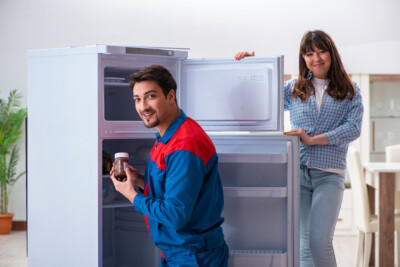My Refrigerator Is Not Cooling Only Freezing Foods?
If your condenser fan motor is not working, you may be getting colder fridge, but not any cooling at all in freezer. If the condenser fan is not working correctly, your fridges temperature can go up, and your compressor can get too hot. Without a functioning fan, it is easy for your fridge to get too hot and stop cooling.
If the refrigerators fan is still working, but the fridge is not cooling, it is possible that either the compressor or the compressor startup relay is defective. That is why, even though your compressor is running, your fridge is unable to maintain freezing cold temperatures in order to keep food safe. If the compressor is not running, the freezer cannot freeze your perishable items.
If the fan motor for the evaporator fails, your freezer cannot freeze food, as the air that is being circulated will not get cold enough. The evaporator fan motor pulls air through evaporator coils (the cooling elements) and circulates the air through your freezer and fridge. In a refrigerator that has a single evaporator, the evaporator is located in the freezer compartment. The evaporator fan is the part of your fridge that blows out the cold air that you feel when you open the doors.
There are coils located underneath or behind the refrigerator which cool down and condense the refrigerators refrigerant. To clean your refrigerators coils, just take the cooler out from behind the wall and wipe down the area behind the cooler. If your fridges coils are too dusty or clogged, then the compressor has to work harder.
When your fridges coils are clogged, they cannot release heat effectively, so your compressor works harder to keep temperatures cool enough. The condenser coils must be exposed and cleaned in order for them to generate the type of cool that is necessary for the fridge to work. Every once in a while, you might want to open the lower or back panels of your refrigerator and clean out the condenser coils in order to ensure that they are able to generate maximum cold.
If condenser coils are noticeably dirty, the refrigerator is unable to keep proper temperatures. The fridge should be able to maintain an adequate temperature — provided that you keep the doors closed — until you are done cleaning your fridges coils.
The one exception is if your fridge has evaporator coils inside of the freezer. The heat exchanger and condenser coils are mounted outside of the cooler, as well as the evaporator coils within the unit.
The evaporator fan is responsible for pulling cold air from the other set of coils, which is then circulated through the whole unit – first in the freezer, and then into the cooler (or fresh produce section). The refrigerant runs through the other set of coils and turns to gas, making it cooler. It is standard to find most fridges using a fan to push the cold air from inside the freezer to an evaporator, which is then forced to an area inside the fridge to maintain the cold temperatures.
Some side-by-side fridges (especially older models) have a vented system to direct the cold air out of the freezer and into the cooler. The thermostats of side-by-side refrigerator/freezers are typically located at the rear, whereas bottom-of-the-counter units are more likely to have the thermostat below the refrigerator. Most refrigerators generate all of their cooling for the freezer, and then keep cooler parts cool by using venting between the refrigerator and freezer areas.
To make sure you get a good temperature, you will want to leave space to let air circulate properly between your freezer and fridge areas. We mentioned that air circulation is a big part of keeping the fridge and freezer temperature optimum. To maintain your whole refrigerator at its optimal cool temperature, airflow is necessary in the freezer compartment.
If boxes of food are blocking the air vents, the cold air may get blocked from moving throughout the refrigerator. When air vents cannot open, cold air cannot move from your freezer into your refrigerator compartment, making your cooler warmer. If an air damper is not working properly, your refrigerator may get too cold, which will result in food inside becoming frozen and unusable.
If An air damper is controlled incorrectly, it may lead to improper temperature settings, which may result in vegetables freezing inside of your cooler drawers, or other icing potentially occurring within your coolers interior.
This can also cause the freezer to get too cold, causing the cooled foods to freeze later. If this happens, the freezer compartment can still be cooled, but your fridge does not. If your freezer starts creating ice in the wrong places, like in vents or the coils of your evaporator, it could mean that you have the freezer set to the correct temperature, but your fridge is too hot. An ice maker that is running continuously may be making your freezer too cold, thereby making the fridge too hot.
If a thermostat is not working, it causes the compressor to run harder than it should, causing your fridge to over-freeze your food and waste. If you hear the compressor running, but the refrigerator is not cooling, it is most likely because of either frost-clogged evaporator coils or stuck or broken evaporator fans.
Normally, your fridges condenser fan and compressor, located near the floor in the back of most fridges, turn on when your thermostat calls for extra cooling. The condenser fan motor has a main job: moving air across the condenser coils, dumping heat, and thus decreasing the temperature. The temperature inside the fridge is maintained by a number of inward-flowing, outward-flowing air vents.
For freezer repairs in Oklahoma City contact Appliance Repair OKC Services by calling them at 405-378-4566 or you can visit our website at https://www.okcappliance.com or also our Google business page at https://cutt.ly/YEnc8qk. Call today!

